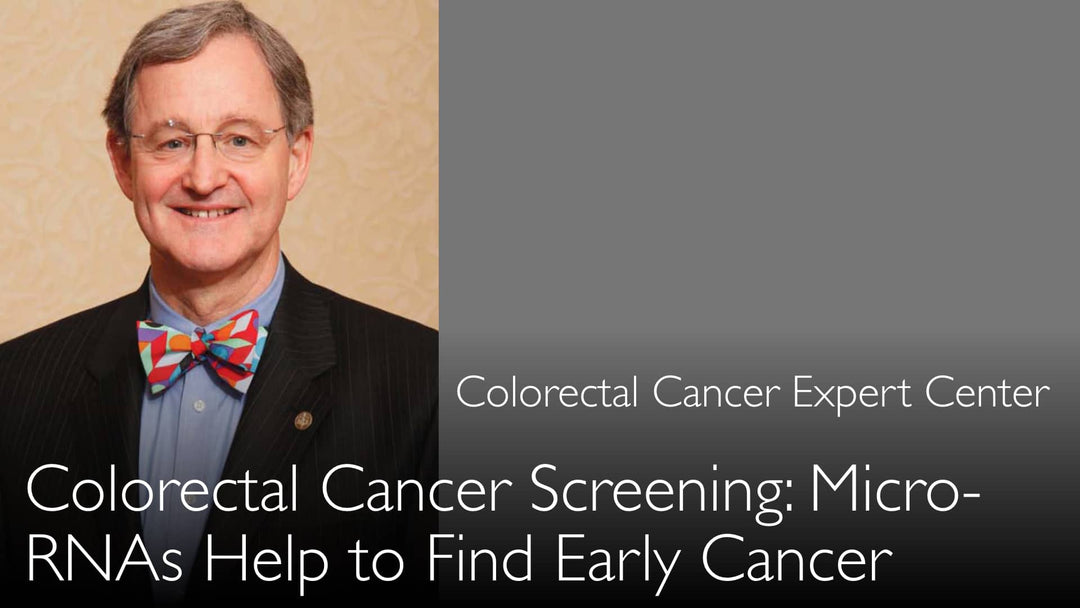מומחה מוביל בגסטרואנטרולוגיה ובבדיקות סקר לסרטן המעי הגס, ד"ר סי. ריצ'רד בולנד, MD, מסביר כיצד סמני מיקרו-רנ"א בדגימות דם וצואה מציעים שיטה לא פולשנית מבטיחה לגילוי מוקדם של סרטן המעי הגס. הוא דן במגבלות של הבדיקות הצואתיות הקיימות ומדוע ניתוח מיקרו-רנ"א יכול לשפר משמעותית את הרגישות בזיהוי פוליפים טרום-סרטניים וגידולים בשלב מוקדם.
סמני MicroRNA: פריצת דרך בגילוי לא פולשני של סרטן המעי הגס
קפיצה לפרק
- MicroRNA בגילוי סרטן המעי הגס
- מגבלות השיטות הנוכחיות לגילוי סרטן המעי הגס
- בדיקות צואה לעומת בדיקות דם לגילוי MicroRNA
- יתרונות ניתוח MicroRNA על פני בדיקות DNA
- גילוי נגעים טרום-סרטניים לפני התפתחות הסרטן
- כיוונים עתידיים בגילוי סרטן המעי הגס
- תמליל מלא
MicroRNA בגילוי סרטן המעי הגס
ד"ר סי. ריצ'רד בולנד, MD, חושף כיצד ניתן לגלות microRNAs - מולקולות גנטיות קטנות הנמצאות בגידולי סרטן המעי הגס - בדגימות דם וצואה. סמנים ביולוגיים אלה מציעים גישה מהפכנית לגילוי לא פולשני של סרטן המעי הגס. הגילוי ש-microRNAs נשארים יציבים בדגימות צואה הפתיע את החוקרים, שכן בתחילה סברו שמולקולות אלה שבריריות מדי לגילוי בצואה.
מספר חברות בארה"ב ובאירופה מפתחות כעת בדיקות מסחריות המנתחות דפוסי microRNA לגילוי מוקדם של סרטן המעי הגס. ד"ר סי. בולנד, MD, מדגיש שחתימות גנטיות אלה מופיעות לא רק בגידולים ממאירים אלא גם באדנומות טרום-סרטניות מתקדמות, מה שהופך אותן לאידיאליות לגילוי מונע.
מגבלות השיטות הנוכחיות לגילוי סרטן המעי הגס
שיטות מסורתיות לגילוי סרטן המעי הגס מתמודדות עם אתגרים משמעותיים, כפי שמסביר ד"ר סי. ריצ'רד בולנד, MD. בדיקת דם סמוי בצואה מסוג גויאק (guaiac fecal occult blood test) ובדיקות אימונוכימיות צואתיות (fecal immunochemical tests - FIT) חדשות יותר סובלות ממגבלות רגישות וסגוליות. בדיקות צואה אלה מבוססות דם עלולות לתת תוצאות חיוביות שגויות ממקורות דימום לא-סרטניים כמו טחורים או מחלת חניכיים.
ד"ר סי. בולנד, MD, מציין שהגישות הנוכחיות הדורשות מהמטופלים לאסוף ולשלוח דגימות צואה מתמודדות עם אתגרי היענות. רבים מוצאים את התהליך לא נעים, מה שמוביל לשיעורי השתתפות נמוכים יותר בגילוי למרות שסרטן המעי הגס הוא אחד הסרטנים הניתנים ביותר למניעה כאשר מתגלים מוקדם.
בדיקות צואה לעומת בדיקות דם לגילוי MicroRNA
בעוד שניתוח microRNA בצואה מראה הבטחה, ד"ר סי. ריצ'רד בולנד, MD, מציע שבדיקות דם עשויות בסופו של דבר להיות מקובלות יותר על מטופלים. בדיקות דם מבטלות את מחסומי ההיענות הקשורים באיסוף צואה תוך כדי הצעת יכולות גילוי דומות.
עם זאת, עבור מטופלים המוכנים לספק דגימות צואה, ד"ר בולנד תומך strongly בשילוב ניתוח microRNA בכל בדיקת גילוי מבוססת צואה. הוא מסביר ש-microRNAs מספקים אות ביולוגי חזק יותר ממוטציות DNA מכיוון שכל תא מכיל מספר עותקים של מולקולות אלה compared to just two DNA copies.
יתרונות ניתוח MicroRNA על פני בדיקות DNA
ד"ר סי. ריצ'רד בולנד, MD, מדגיש יתרונות טכניים מרכזיים של סמני microRNA compared to גישות בדיקה מבוססות DNA. Some companies are attempting to combine fecal immunochemical tests with analysis of methylated DNA and KRAS mutations, but Dr. Boland considers this approach unnecessarily complex.
"MicroRNAs should be very easy to measure," explains Dr. Boland. The natural amplification of microRNA signals in cells makes them particularly sensitive markers for early cancer detection. This amplification effect could allow identification of tumors at earlier stages than current methods permit.
גילוי נגעים טרום-סרטניים לפני התפתחות הסרטן
יתרון קריטי של גילוי microRNA, according to ד"ר סי. ריצ'רד בולנד, MD, is its ability to identify precancerous adenomas before they become malignant. Current fecal blood tests often only detect cancer after it has progressed to bleeding stages, missing the optimal window for prevention.
"Colon polyp doesn't have to be fully malignant to get these abnormal microRNA genetic signatures," notes Dr. Boland. This capability could transform colon cancer screening from early detection to true prevention by enabling removal of dangerous polyps before cancer develops.
כיוונים עתידיים בגילוי סרטן המעי הגס
ד"ר סי. ריצ'רד בולנד, MD, envisions a future where microRNA analysis becomes standard in colon cancer screening programs. He emphasizes the need for tests that are both highly sensitive and specific to colorectal abnormalities, reducing false positives from other gastrointestinal sources.
As research progresses, combining microRNA signatures with other biomarkers may further improve screening accuracy. Dr. Boland's work suggests that within several years, patients may have access to simple blood tests that provide colon cancer risk assessment comparable to current stool-based methods but with greater convenience and patient acceptance.
תמליל מלא
ד"ר אנטון טיטוב, MD: גילוי סרטן המעי הגס בשיטות לא פולשניות הוא חשוב. מתגלים סמני גידול חדשים ורגישים לסרטן המעי הגס. זיהוי microRNA בדגימות צואה ובדם יכול לחזות את סיכון הסרטן.
סרטן המעי הגס והחלחולת הוא הסרטן הנפוץ ביותר כאשר בוחנים נשים וגברים together. כמעט 1.5 מיליון אנשים ברחבי העולם מאובחנים עם סרטן המעי הגס מדי שנה. עם זאת, מקרי מוות מסרטן המעי הגס ניתנים למניעה מלאה through screening for precancerous polyps and early detection of colon cancer tumors.
Colonoscopy remains the standard method of screening for colon cancer, but less invasive methods are being developed. MicroRNA identification is a non-invasive colon cancer screening method. You have shown that microRNA can be identified in fecal samples. So microRNA from colon cancer tumors can serve as a biomarker for early detection of colorectal cancer by analyzing a small fecal sample.
ד"ר אנטון טיטוב, MD: How can microRNAs be used in colorectal cancer screening?
ד"ר סי. בולנד, MD: We have just discussed finding miR-21 and other microRNAs in the blood. Several years ago, one of the research fellows in the lab suggested that microRNAs differentially expressed in colon cancer might be present in stool. Initially, I didn't think we could find microRNAs in fecal samples. I thought microRNAs would be too fragile and broken down in feces. But it turned out he was correct—we can isolate microRNAs in fecal samples.
There is at least one company in the USA and more in Europe working on methods of early colon cancer detection by analyzing fecal samples. Identification of microRNAs is one way to find early colon cancer.
So far, we have used a guaiac test to detect blood in fecal samples for early colon cancer detection. Now most people use a fecal immunochemical test, but it still has sensitivity and specificity problems for cancer detection.
One company in the United States is adding methylated DNA analysis and KRAS tumor mutation analysis to fecal testing for colon cancer. I think it's too hard to do that—it will be very difficult to make such fecal sample tests work well. MicroRNAs should be very easy to measure. I'm hoping they will start incorporating microRNA analysis in fecal sample testing for colon cancer.
The problem is that many people find it difficult to collect a stool sample, put it in the mail, or give it to their doctor. People just don't like to do that. So a blood test would be better. But if people are going to do any kind of fecal test to detect colon cancer, they must test for microRNAs.
There are multiple copies of microRNAs in each cell but only two copies of DNA. So with microRNAs, you have an amplified signal by definition. Companies working on early colon cancer detection methods must look at microRNAs. If you're going to measure anything in stool, microRNAs will probably be the most sensitive test for finding early-stage colon cancer tumors.
ד"ר סי. בולנד, MD: These microRNAs are present in colon cancer tumors but also in advanced colon adenomas. A colon polyp doesn't have to be fully malignant to have these abnormal microRNA genetic signatures. This will be a very exciting non-invasive early screening method. It's important to identify precancerous lesions because finding blood in feces signifies that colorectal cancer has already become quite advanced.
Yes, another problem with blood in feces is that it can come from anywhere in the gut. You could have bleeding from your gums or hemorrhoids. If we can find a test for early colon cancer detection that is very specific for cancer identification, it will be much more powerful.





